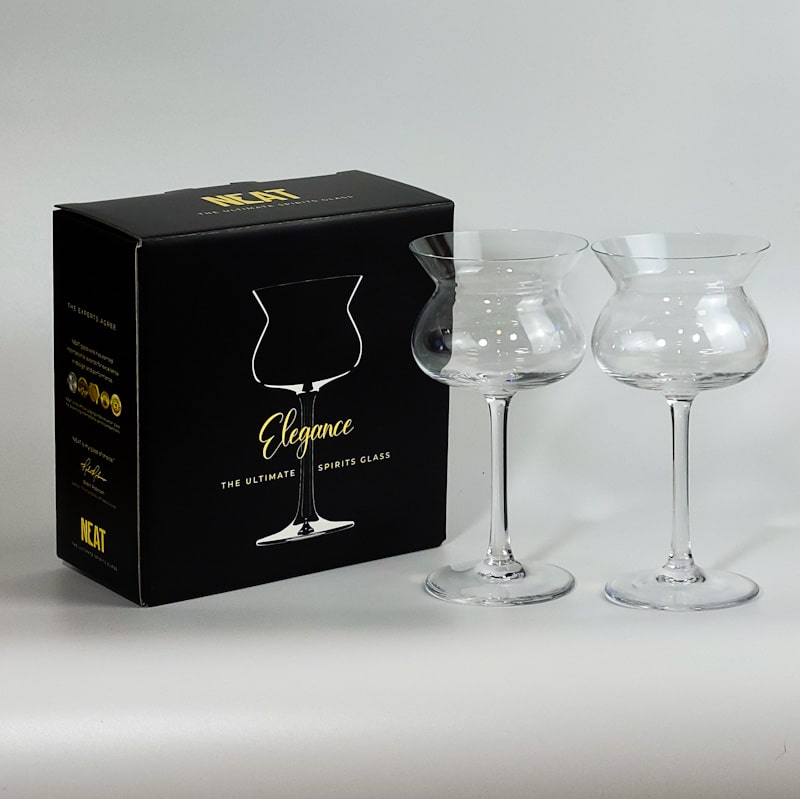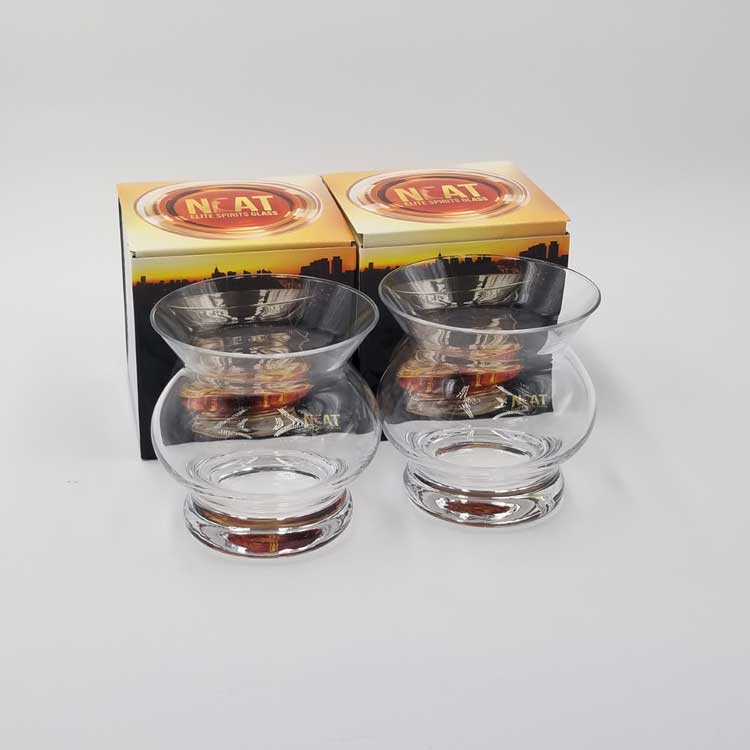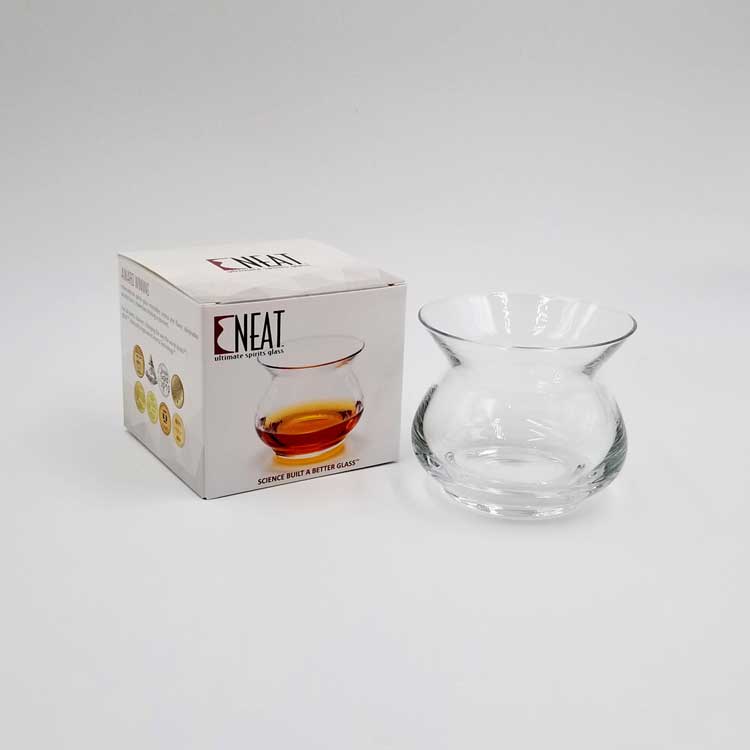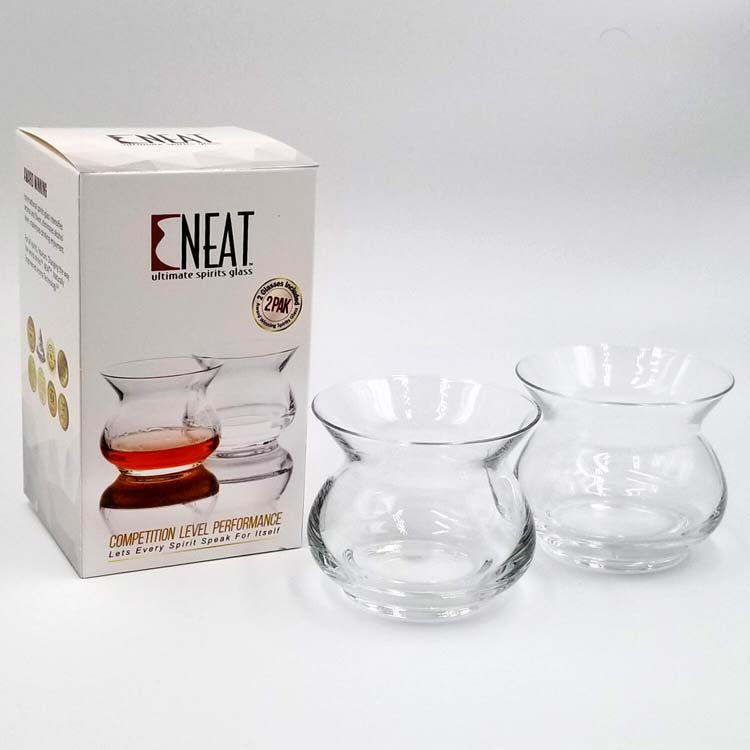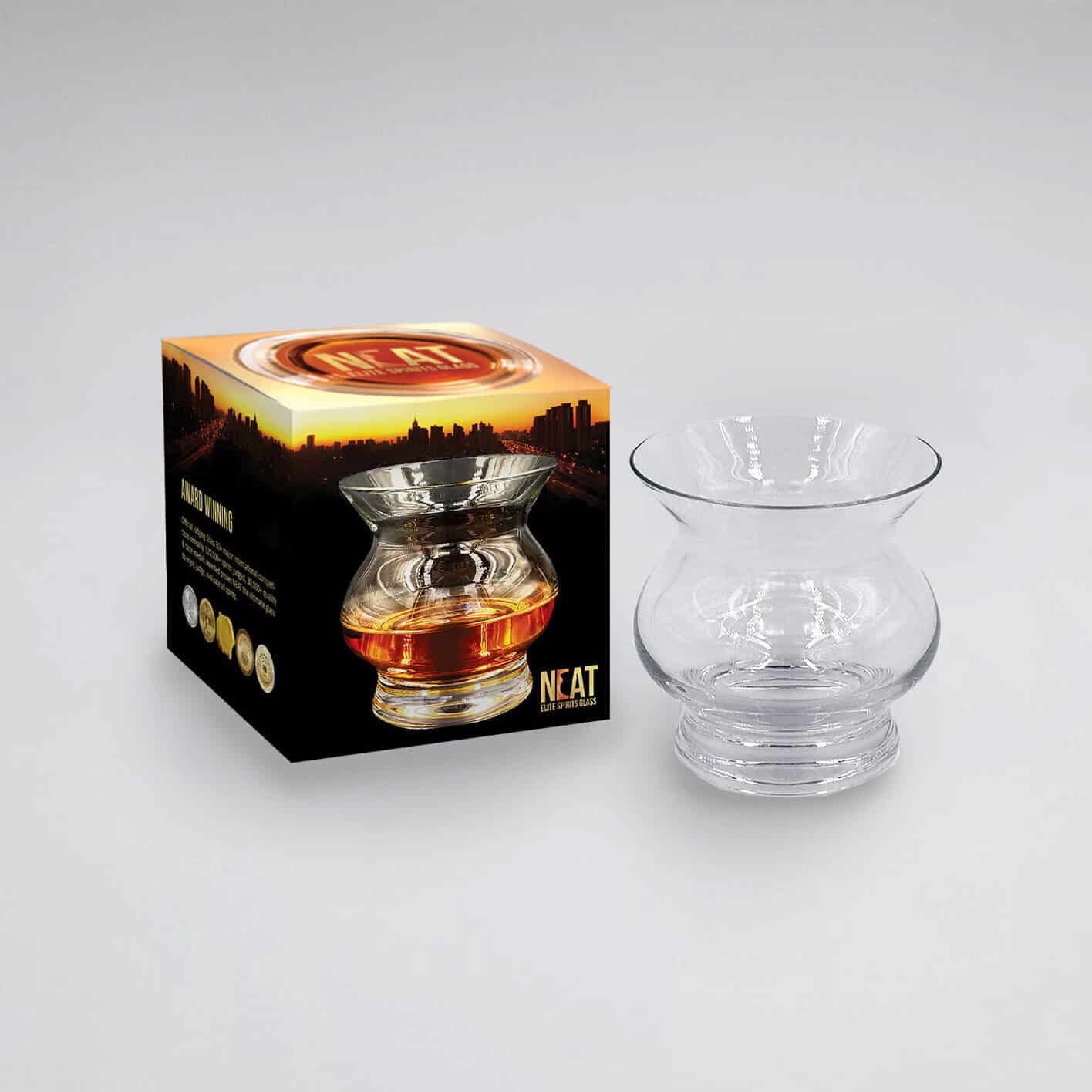
Choosing the Best Spirit Glass by Comparing Popular Styles
Displaying all aromas for easy access, avoiding overly abundant, nose-numbing ethanol, and detecting the subtler aromas usually masked by ethanol are the basic guidelines for choosing a suitable diagnostic glass to give the nose its best chance to work to its fullest capabilities.
How does glass shape affect aroma detection? Choosing a functional tasting glass is all about how shape manipulates: (1) the “weather in the glass” to get the most aromas to the nose, and (2) the aroma display for easier detection and identification. From previous discussions of evaporation and aroma clouds, weather in the glass, and swirling, shape is the crucial factor in coaxing aromas to the nose. WARNING: The ensuing discussion may be tedious and detailed, but provides the necessary knowledge to understand where to find aromas in different glasses, and where the dangers of nose-numbing ethanol lurk.
Summarizing earlier presentations, we learned that we can enhance aromas by (1) covering the samples to saturate the headspace with evaporated aroma molecules, and (2) applying vigorous swirling to break surface tension and release more of the complex character aroma molecules. Each of the three most commonly used spirits glasses has attributes (denoted in exhibits in green) and flaws (red) which have a profound effect on the presentation of the aroma cloud to the nose. Following is a list of pertinent questions to address when choosing a functional spirits glass:
- Is the bowl large enough to permit effective swirling to release more aromas?
- Is the height of the glass rim from the liquid low enough to pick up elusive large mass character aromas?
- Do the headspace volume and rim size promote evaporation to the nose while avoiding the concentration of nose-numbing ethanol?
Taking each question separately, and in depth, we consider each of the three common spirits glass shapes. Note that some previous material is revisited here from our previous presentations to get a total picture of the major aspects of glassware choice.
Is the bowl large enough to permit effective swirling to release more aromas? Swirling is the “engine” that powers and enhances evaporation by releasing more aromas and driving them to the nose.

Since tulip glasses are the most commonly accepted spirits glasses worldwide, we use them as the base glass for comparison and assigned a factor of 1 for each design component that contributes to swirling effectiveness. Shape factors for the other two styles are calculated from their respective measurements for commonly used sizes. Green is good.
The snifter has the largest bowl. Swirling velocities and therefore aroma release is much better in the snifter than in any of the other common vessels. Considering swirling alone, the snifter averages 3.5 times (combining both wetted sides and liquid surface area) more effective than the baseline tulip glass with its evaporation factors set to 1. The tumbler comes in a distant second, yet is about 1.8 times as effective as the tulip. The tulip fails dismally in the quest to release more aromas through swirling.
Is the height of the glass rim from the liquid low enough to pick up elusive large mass character aromas? Of the three glasses, the tulip rim height from the liquid surface at best fill, is the lowest, and therefore should pick up more character aromas. However, the search for aromas plays out more definitively as other control factors are considered.

At rest, aromas tend to stratify by molecular mass, heavy molecules at the liquid surface, and lighter molecules at the rim, pushed up by vapor pressure and slightly mixed by quickly evaporating and dispersing ethanol currents (the “weather in the glass”). Tall rim heights tend to prevent lighter character aromas from reaching the rim and ethanol, the lightest compound, becomes the only detectable aroma at the rim of very tall glasses. This effect is modulated significantly by larger volume headspaces which provide more room for “weather in the glass” to move character aromas to the rim for detection, particularly when the glass is swirled. In general, the closer the nose is to the liquid, the more aromas are available for detection.
Experiment: Place a tall water glass, a tumbler, and a tulip glass on a table left to right, about one foot apart, each containing exactly 1 oz. of the same spirit (preferably a spirit with complex aromas, such as an aged whiskey, rum, or reposado/anejo tequila/mezcal). Do not cover the glasses, leave them undisturbed for at least two minutes to permit the sidewalls wetted from the pour to return to the liquid, and character aromas to stratify in the glass. Without touching the glasses, place your nose at the rim plane of each and lightly sniff the aromas. Pause for a two-minute recovery before sniffing each of the next samples to clear the olfactory. Record the aromas you detect from each glass.
Repeat the process but swirl each glass vigorously before nosing. This experiment will highlight the effect of height on detectable aromas as well as the importance of swirling to release aromas. The taller glasses should have fewer aromas, and the swirled glasses should have noted more aromas than when they were not swirled. Add a large snifter and retry to demonstrate the snifter cloud effect.

Do the headspace volume and rim size promote evaporation to the nose while avoiding the concentration of nose-numbing ethanol? Headspace volume is the volume bounded and enclosed by the surface of the liquid, the rim plane, and the sides of the glass. As we shall see, the size and shape of the headspace and the ratio of rim area to bowl area is important to creating a continuous and uninterrupted flow of aromas to the rim after evaporation.

Considering headspace volume, the tulip’s lower height advantage is quickly negated because the upper third of its tiny headspace volume is occupied by faster-moving ethanol molecules, forming a barrier to the movement of more character aroma molecules to the rim for detection and identification. Additionally, the nose is confined to the outside of the glass due to the small rim size (see picture in exhibit above). Considering the ethanol concentration, the nose should not be forced inside the tiny-rimmed tulip/chimney-shaped glass. Green oval denotes an attribute of a vessel and red is a flaw.
A major design issue is the sidewall convergence of the glass. If the rim diameter is too small compared to the maximum bowl diameter (ratio of rim to bowl), the light ethanol aromas will concentrate. The glass sides act as a funnel collecting and compacting more of the faster-moving-lighter ethanol molecules into a tiny space at the rim, battling each other to get out so they can disperse, and they push their way to the front of the line, in any space they can fit into ahead of character aromas, holding the heavier aromas in the bottom bowl of the glass to move to the rim and exit when they can find a gap in the line to accommodate their larger size. Recall the morning subway commute into the city where those who are quickest, lightest, and without luggage always are dodging and cutting in wherever there is space to board the train first and get the best seats. If you are not ethanol fast, you may have to stand (remain in the bottom of the bowl).
In other words, although natural ethanol “weather in the glass” is responsible for bringing many aromas to the rim without swirling, the ethanol stratification and concentration at the rim tends to crowd out character aromas, and many larger, heavier character molecules remain in the lower bowl. Swirling releases aromas by breaking surface tension and the “swirl storm” brings them closer to the rim for detection, as the overall glass shape plays an integral role in how they get out of the glass, and/or to the nose.
Headspace volume versus rim size is the classic spirits glass design conundrum. For decades the spirits industry has adopted the stance that all spirits glasses must have small rims to concentrate aromas, believing that small rims will trap all the aromas within easy reach of the nose so none can escape detection. At first glance, the statement appears logical and irrefutable. Delving deeper reveals that ethanol, the most abundant molecule, is concentrated as well, and will dominate and obscure the detection of those subtle, heavier character aromas by quickly numbing the nose.
The primary interest of glassware manufacturers has always been to meet customer needs rather than question why, and the great opportunity for functionality has been left for others to discover. Style-driven, they assumed the spirits industry must surely know what they want, and they dutifully complied. That’s the major reason why most tulip-style glasses are nearly the same height (without stem) and the same bowl and rim diameter with only minor styling changes. The glass manufacturers would not dare to be different and risk losing revenue. The few sheep who ventured too far from the flock were eaten by the wolves; as those few who bucked the trend of the tulip/chimney were quickly beaten down and rejected as the spirits industry (particularly whiskey) forcefully gravitated toward institutionalizing the tulip shape as an iconic spirits drinker identification badge, completely ignoring function. Visually remove the stem from the many different tulip bowl shapes to see the uncanny similarity in rim and bowl diameters and bowl height (see exhibit). A few distinguish themselves by improving functionality with a flared rim, which permits a quicker ethanol escape path. More on flared rims in a later discussion.

Rim size vs headspace is all about letting the nose enter into the headspace and providing a headspace large enough to let the “weather in the glass” bring aromas closer to the rim for detection. A small headspace concentrates rapidly evaporating nose-numbing ethanol, and when nosing. Too much headspace restricted by a tiny rim provides no ethanol escape route except through the nose, a recipe for quick ethanol anesthesia. Glassware designers fail to take the ethanol escape aspect of headspace into account.
Since the tulip headspace is too small to be functional as a collector of aromas for nosing, the nose has to pick through the ethanol cloud above the rim, sniffing several times to discover detectable aromas before the olfactory sensors are numbed. There is no known specific position in the tulip aroma cloud (above the rim) which can repeatedly and dependably provide character aromas for detection. Aroma detection is hit or miss and becomes a hunting expedition in a minefield of nose-numbing ethanol.
On the opposite side of the spectrum is the snifter. Examining the green circles in the chart, one would think that the snifter is best because it swirls better, and has much more headspace. The snifter may have 5 times the rim area of the tulip, but the ratio of rim area to max bowl area is 0.5, clearly demonstrating its rim restriction as well as its propensity to concentrate ethanol at the rim.
Recalling the design conundrum of rim size vs headspace, we immediately see that the headspace on the snifter is so large, and swirling so well, that the whole headspace is filled with a nose-numbing cloud of ethanol, demanding that the nose be placed inside the glass to get a whiff because the small rim tends to hold the entire cloud within the headspace.
There is not much to smell above the rim in a snifter, and the evaluator must pick through huge amounts of nose-numbing ethanol to find a character aroma, in the snifter. At the very least, the tulip shape provides the option of smelling above the rim to discover aromas without the constant onslaught of nose-numbing ethanol. In addition, the basic design of the larger headspace snifter takes a much longer time to approach saturation of the aroma cloud with character aromas and swirling populates the headspace with copious amounts of ethanol aromas with only a tiny escape area.
Overall, what is the best glass of the three most common styles for evaluating spirits? Arsilica, Inc. performed extensive testing (see exhibit notes) on all three common styles. Green is a favorable attribute, and red is a flaw.

In conclusion: Popular tulip shapes, though shorter than other common vessels, are tight-rimmed and concentrate ethanol which increases difficulty in performing accurate diagnostics. Importantly, the origin of the tulip shape was the sherry copita designed for 20% ABV fortified wines, and attempting to enjoy a straight (no water, no mixer, no ice) 40% ABV spirit from a glass designed for 20% ABV results in an ethanol nose bomb, sure to numb your nose quickly. It is the price of maintaining “tradition.”
The snifter has a completely different set of problems. Although it swirls the best, the snifter creates a confined cloud of ethanol guaranteed to numb your nose quickly. At least with the tulip, a common sense approach can be employed to sniff around the edges of the aroma cloud above the rim. Takeaway: The tumbler is the best glass of the three to combat nose numbing and detect and identify spirit character aromas.
In the next presentation, we will explore how the origins and history of common spirits glasses led to their acceptability for certain spirits. Following that, we will explore other ways to approach a useful aroma profile for evaluation.

